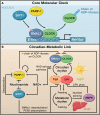PARP around the clock
- PMID: 20850006
- PMCID: PMC3694762
- DOI: 10.1016/j.cell.2010.08.037
PARP around the clock
Abstract
Cells possess internal ∼24 hr or circadian clocks that synchronize physiological processes with daily cycles of light and nutrient availability. In this issue, Asher et al. (2010) find that PARP-1 (poly(ADP-ribose) polymerase 1) modifies components of the clock machinery in response to feeding, providing a mechanism for how metabolic rhythms coordinate with circadian rhythms.
Copyright © 2010 Elsevier Inc. All rights reserved.
Figures

Comment on
-
Poly(ADP-ribose) polymerase 1 participates in the phase entrainment of circadian clocks to feeding.Cell. 2010 Sep 17;142(6):943-53. doi: 10.1016/j.cell.2010.08.016. Epub 2010 Sep 9. Cell. 2010. PMID: 20832105
References
Publication types
Grants and funding
LinkOut - more resources
Full Text Sources
Miscellaneous

